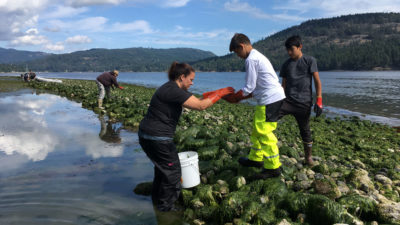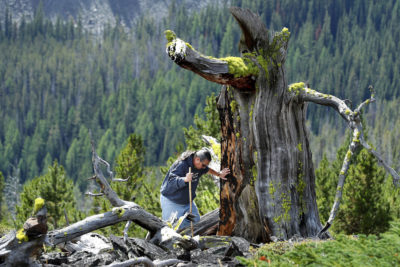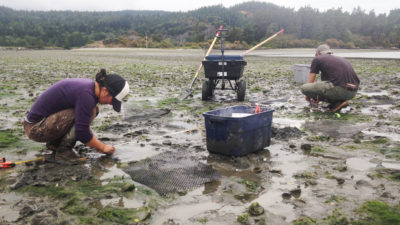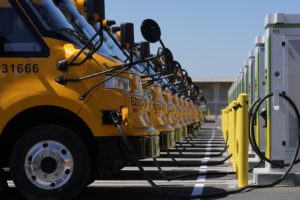On a hot summer’s day, marine ecologist Courtney Greiner walks the shore of a rocky Washington beach at low tide with a handful of staff and interns. They stake out the ground and hunch down, digging up the top two inches of mud, silt, and gravel looking for baby clams.
For thousands of years, the indigenous peoples of the West Coast would build rock walls at the low tide line, allowing sand to pile up behind them, making the slope of the beach gentler, and expanding the area of the intertidal zone that clams like to call home. These simple clam gardens are effective at boosting shellfish numbers, and have long been used to improve food security for traditional peoples.
Now the Swinomish are reviving the old idea to build the first modern clam garden in the United States. Greiner, who works for the Swinomish tribe, is collecting the data that will help the tribe determine the garden’s best location. The project aims to boost clam numbers, providing both a sense of purpose for the community and additional food as other resources, like salmon, decline.
This is just part of the Swinomish’s plan to ensure the ongoing prosperity of their people in the face of a changing climate. “They were the first native community — and really one of the first communities, period — to make climate adaptation a priority,” says Meade Krosby, a conservation biologist with the University of Washington’s Climate Impacts Group. The tribe’s climate proclamation came out in 2007, and their action plan, published in 2010, was one of the first such documents in the United States. “They’re early adopters and really innovative,” she says.
The Swinomish have already launched projects aimed at helping the community adapt to a shifting climate in the Pacific Northwest. To protect salmon runs, the tribe is working on the Skagit River to create better spawning beds and is planting trees to provide shade and reduce river temperatures. In addition, the tribe is fighting to block mining operations in the headwaters of the Skagit in British Columbia, which could impact waters downstream.
“Tribes have always been adapting to climate change — now we have to adapt even faster,” says one Navajo leader.
Another project aims to restore a healthy population of native Olympia oysters, long threatened by pollution and crowding out by competitive Pacific oysters and now impacted by ocean acidification. Workers have brought in truckloads of oyster shells and dumped them on beaches to provide new homes for imported natives; the imports grow well, says Greiner, but so far have yet to produce a next generation of shellfish. “It’s a learning process,” she says. A site for the first clam garden should be chosen by next year. And a wetlands project is documenting the local plants that have ecological and cultural importance to the Swinomish, as part of efforts to better manage the changing coast for salmon and farmers alike.
Across North America, other indigenous communities are stepping up to formulate and enact climate action plans to protect their way of life. In 2019, the Karuk tribe of northern California released its climate adaptation plan with a recommendation to return to prescribed burning, an old idea that might help to ease California’s wildfire problems. The Tulalip tribes of Washington state are relocating nuisance beavers from urban areas back to traditional watersheds to help lower river temperatures and aid salmon populations; they are also redirecting agricultural runoff for electricity generation. The Jamestown S’Klallam tribe in Washington is removing invasive butterfly bushes from the banks of the Dungeness River to help protect its salmon. The Confederated Salish and Kootenai Tribes of Montana are gathering and planting seedlings of the whitebark pine that are more resistant to warming-related diseases such as blister rust. Alaskan tribes are using microscopy to identify harmful algae blooms spurred by warming waters. The list goes on.
“Indigenous peoples have always been on the front lines,” says Nikki Cooley, who grew up without electricity or running water on the Navajo Nation reservation and now co-manages the Tribes and Climate Change Program for the Institute for Tribal Environmental Professionals (ITEP) in Flagstaff, Arizona. “Tribes have always been adapting to climate change. Now we have to adapt even faster.”
Tribal program manager Mike Durglo Jr. examines what remains of a 2,000-year-old whitebark pine on the Flathead Indian Reservation in Montana, where trees are dying from warming-related diseases. Chip Somodevilla/Getty Images
As Krosby puts it, indigenous peoples “have unique connections to the land and are feeling impacts the earliest and most severely.” One study found that coastal indigenous communities eat 15 times as much seafood as non-indigenous people in the same country — food that is being heavily impacted by everything from pollution to warming waters and ocean acidification. In the far north, buildings are collapsing and indigenous communities relocating as permafrost thaws, and traditional practices like reindeer herding are being threatened as winter snow changes to freezing rain, which locks up winter forage like lichens under ice.
“It’s happening all over the world,” says Brian Cladoosby, chairman of the Swinomish tribal community. “I have seen an elder standing on their cemetery in [the Pacific island nation of] Tuvalu and it was covered with water — they can’t bury their people there anymore.”
These are communities that have relied on the land for generations, building an intimate knowledge of the natural cycles of plants, animals, and weather. Unlike the traditional Western worldview that humanity can and should seek dominion over the environment, indigenous populations tend to view humanity as part of an interconnected whole. “We knew if we impacted one part of the web, the whole thing could fall apart,” says Cladoosby.
Adds Cooley, “We put our non-human relatives first, meaning the trees, the sky, the water. We don’t treat them as objects to be studied in a lab. We revere them.”
Indigenous communities tend to think many generations ahead when planning how to utilize resources.
Indigenous communities also tend to think many generations ahead when planning how to utilize resources — a lot further than a U.S. presidential cycle allows. “America can’t even think past 4 years,” says Don Sampson, Umatilla Tribe member and head of the climate change project for the Affiliated Tribes of Northwest Indians (ATNI), a 57-tribe consortium. “It’s a short-sighted country.”
The UN Intergovernmental Panel on Climate Change’s recent reports have acknowledged with “high confidence” that adaptation efforts benefit from the inclusion of local and indigenous knowledge. “One of the things that comes across really clearly is the fact that indigenous peoples are by far the most effective stewards of biodiversity,” says Krosby. “They do the best job.” One study showed, for example, that deforestation rates across the Amazon were two to three times lower in indigenous-held lands. According to the UN Intergovernmental Science-Policy Platform on Biodiversity and Ecosystem Services, indigenous peoples hold or manage a disproportionate amount of formally protected areas and areas with low human impact: these groups occupy 28 percent of the planet’s land, but more than 40 percent of protected areas. In Canada, the government funded an Indigenous Guardians program in 2017, recognizing that First Nations communities are well placed to serve as stewards of the land.
Yurok tribal member Jess McLaughlin manages a prescribed burn near Somes Bar, California last year. Stormy Staats, Klamath-Salmon Media Collaborative
Cooley estimates that ITEP has worked with representatives of some 300 of the 574 tribes in the United States and that there are now more than 50 tribal climate action plans in effect. “In the past five years, tribal climate action plans have exploded,” she says. Sampson’s goal is to ramp that up to 100 percent within five years: “We have to accelerate the ability and capacity of the tribes; we want all tribes to identify the impacts and have a plan for that.”
Sampson also notes that many tribes are making huge strides on energy independence, weaning themselves off fossil fuels to protect both the environment and their economic future: the Navajo nation, for example, long reliant on coal, has made big investments in solar power.
The Swinomish tribe makes its home in western Washington, on an island carved out by the narrow Swinomish Channel. The land is low and at risk from sea level rise: A five-foot increase this century — at the high-end of sea level rise estimates — could swamp more than 1,100 acres of the 10,000 acre reservation, including all its agricultural lands. Part of the Swinomish territory is particularly sacred as a fishing and shellfish gathering spot, says Cladoosby. “One year, just a normal tide, not a storm surge, covered up that area,” he recalls. “That had never happened before. It was eye opening for us.”
About half of the reservation’s acreage is forested, and so is at risk from wildfire, especially in a hotter, drier climate. The tribe has just over 1,000 members, many of them relying on “first foods” — from shellfish to deer — for their welfare. The surrounding Salish Sea has seen salmon populations crash mysteriously over the past 30 years; the impacts of climate change — including reduced stream flows and warmer stream temperatures — have been cited as one culprit. Dungeness crab and shellfish larvae are in some places literally dissolving from ocean acidification.
For many indigenous groups, environmental health and human health are deeply intertwined.
In the Skagit River Basin, a shift from snowfall to rain in the surrounding mountains is projected to boost winter river flow but reduce summer flow, drying up tributaries and making waters warmer just as salmon spawn in late summer and fall. “When there’s no water for the salmon to return to, that’s a serious problem,” says Cladoosby.
“There’ve been times I’ve been really negative looking forward,” says Joseph Williams, a Swinomish tribal senator with five children. “Things are looking pretty bleak, especially for our salmon.” But these projects, he says, are proving inspirational to the next generation, helping to bring people together. “As long as we keep our kids excited about taking care of our environment, things remain optimistic,” he says.
For the Swinomish, as for many indigenous groups, it makes little sense to talk about environmental health and human health separately; they are deeply intertwined, with community cohesion and traditional food security being equally vital. Resilience to sea level rise doesn’t just mean managing wetlands, but also combating feelings of despair. Work led by the Swinomish tribe’s environmental health analyst Jamie Donatuto and tribal historic preservation officer Larry Campbell has created a set of health indicators based on these cultural values. They hope this approach will help researchers across the world think beyond simple morbidity and mortality as the only important measures of welfare.
Such work is often done in collaboration with non-indigenous scientists and governments. The University of Washington’s Climate Impacts Group last year released a Tribal Climate Tool, developed in close partnership with relevant tribes, that highlights specific climate impacts expected in local regions — from the number of hot summer days to inches of rainfall expected in coming decades — so tribes can see what they are facing and make decisions about how to adapt.
Swinomish fisheries managers and scientists collect data on how ocean acidification is impacting oyster and clam development. Photo courtesy of Swinomish Indian Tribal Community
A number of such organizations are pushing this work forward in collaboration with local tribes, including the U.S. Geological Survey’s regional Climate Adaptation Science Centers; Krosby is deputy director for the northwest division. And there’s the Pacific Northwest Tribal Climate Change Network, based at the University of Oregon, which partners with Sampson’s division at the ATNI. In October, ATNI’s climate summit in Seattle is expected to attract tribal leaders from across North America, as they work on a national tribal climate crisis agenda for 2020 and beyond. “It’s a revolution that’s happening,” says Sampson. “Watch the tribes: they are going to lead us.”
For Cladoosby, part of that revolution involves re-awakening traditional connections to the land, which have eroded in recent centuries. “Part of the assimilation policy was taking stewardship of the environment out of our hands,” he says, leaving many communities locked in a cycle of trauma and cultural loss, along with drug and alcohol abuse. “Part of breaking that cycle is getting back that respect for the environment.”
“Right now, we are taking baby steps,” says Cladoosby. The Swinomish are still collecting data, securing treaty rights, educating their own people and others, he says. Alongside efforts to adapt and ensure resilience in the face of local change, political activism is also a big part of the picture as it can prevent some development and ensure that tribes maintain control over their lands. He acknowledges it will take time to establish long-term sustainable solutions. “We live in a pollution-based economy; it is based on making money and polluting the landscape,” Cladoosby says. “Trying to change that mindset is like trying to turn a tanker. It doesn’t happen over night.”
Correction, February 13, 2020: A caption in an earlier version of this article incorrectly identified a photo as showing Swinomish tribal members preparing a new clam garden in Washington state. They were participating in a clam garden restoration in British Columbia.





